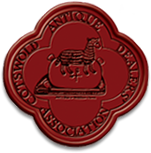The Bromsgrove Guild
 From its inception in 1898 the Bromsgrove Guild of Fine Arts
looked to promote high quality workmanship in the areas of metal casting, wood carving
and embroidery in the mold of the medieval tradition of a guild. This included
apprenticeships for local young men and women, teaching them about art and design and a
trade in the traditional manner.
From its inception in 1898 the Bromsgrove Guild of Fine Arts
looked to promote high quality workmanship in the areas of metal casting, wood carving
and embroidery in the mold of the medieval tradition of a guild. This included
apprenticeships for local young men and women, teaching them about art and design and a
trade in the traditional manner.
The Guild initially had workmen and workshops scattered throughout the country, with work coordinated by Walter Gilbert, the driving force of this project, from the main metal works in Station Street, Bromsgrove, in the midlands region England. The Guild rapidly expanded into other areas, such jewellery making and enamelling and a workshop was soon rented in Stoke Heath specifically for decorative art plaster work.
Gilbert worked hard to promote the Guild’s activities and recruit the best craftsmen. The Guild was showcased in 1900 the British Pavilion at the great Exposition Universelle in Paris. Adverts were also placed showing the skilled craftsmanship of the Guild in the relevant publications of the day such The Builder. The following years saw an influx of talented craftsmen both from other companies such as Coalbrookdale and Morris Singer, and all parts of Europe. It is important to mention Louis Weingartner who became the Guild’s chief designer, sculptor and metal worker in 1904, having trained for 20 years as a jeweller in Florence.
He produced a presentation piece which gained the commission to produce the gates for Buckingham Palace. The piece he put forward was a gate lock surrounded by tumbling cherubs at play. It is thought that Walter Gilbert’s baby daughter Margot was the model for the cherubs which helped secure this most prestigious commission.With success came more commissions and a requirement for a business partner to invest and help run the expanding company. William McCandlish stepped in, though his arrival changed the general feel of the Guild. Previously its disparate craftsmen worked in their own workshops scattered around the country; this now changed as the company became centralised around the Bromsgrove area. Work continued coming in, such as the large commission to fit out part of the luxury liner, Lusitania, and the famous Liver Birds on the Royal Sun Alliance Building, Liverpool.
This pre-war period can be seen as the heyday for the Guild with a Royal Warrant and nearly 150 employees working on many different projects, with offices throughout the UK and even branches in Canada and the USA. It is however sad to note that one of their finest craftsmen, Leopold Weisz, was lost on the Titanic whilst travelling to secure a commission. Though the company carried on working throughout the Great War, Walter Gilbert in 1918 accepted a large salary and incentives to move to a rival company of craftsmen, HH Martin of Cheltenham, and within the inter-war period many of the Guild’s top craftsmen followed him to Cheltenham.
Despite the loss of good craftsmen the company still attracted talent such as Michael Hewan Crichton, and the Guild often competed for works against HH Martin. Guild records show a broad range of projects in England and the USA, ranging from a casket presented to British Prime Minister Stanley Baldwin and a lead fountain of Neptune which went to Philadelphia.
 It is a matter of record that in 1930
the Guild exhibited at Chelsea Flower Show advertising lead and ‘castone’, a
cement based artificial stone. The Guild also advertised bird baths, vases, seats and
sundials, and statues of Spring and Summer selling for £25 in lead and
£5.10s in castone.
It is a matter of record that in 1930
the Guild exhibited at Chelsea Flower Show advertising lead and ‘castone’, a
cement based artificial stone. The Guild also advertised bird baths, vases, seats and
sundials, and statues of Spring and Summer selling for £25 in lead and
£5.10s in castone.
An image of another Bromsgrove Guild trade stand illustrated in The Bromsgrove Guild, An Illustrated History, edited by Quintin Watt, the main source for this article, shows lead ornament and statuary, and even the back view of the lead Pan shown in this catalogue. The great depression of the late 20s hit the Guild hard as a seller of luxury goods. The plight of the company was exacerbated by the loss of their key manager of works Ernest Cowper and other skilled craftsmen who drifted away from the Guild as the work dwindled.
The Second World War saw the much smaller Guild produce shovels and fittings for fire
fighting equipment, and with a brief flourish after the war with commissions for war
memorials and the repair of bomb damage the company was sadly finally wound up in
1966.

 Chinese
Chinese
 Dutch
Dutch
 English
English
 Farsi
Farsi
 Finnish
Finnish
 French
French
 German
German
 Greek
Greek
 Italian
Italian
 Japanese
Japanese
 Portuguese
Portuguese
 Spanish
Spanish
 Swedish
Swedish







